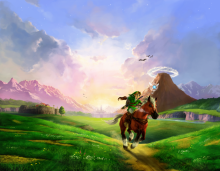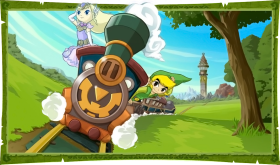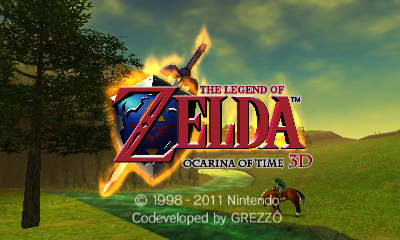The Promise of Ocarina of Time 3D
Posted on January 11 2013 by Hanyou
 Handheld Zelda games always take a different course than their console counterparts. In the current 3D era, this mostly means having a top-down view. The Game Boy Color games, made by Capcom, built off the engine of Link’s Awakening DX (a remake — this will be important later) and bore more than a vague resemblance to its template. This made sense, as the Game Boy Color was the last in a line of mini-NES handhelds, culminating, of course, in a Game Boy Color Super Mario Bros.
Handheld Zelda games always take a different course than their console counterparts. In the current 3D era, this mostly means having a top-down view. The Game Boy Color games, made by Capcom, built off the engine of Link’s Awakening DX (a remake — this will be important later) and bore more than a vague resemblance to its template. This made sense, as the Game Boy Color was the last in a line of mini-NES handhelds, culminating, of course, in a Game Boy Color Super Mario Bros.
The Game Boy Advance was a Super Nintendo, part two. With titles like Golden Sun, Metroid Fusion, and the Final Fantasy, Donkey Kong Country, and Super Mario Advance games, it aped the Super Nintendo, acting as a platform for re-releases as well as new titles that bore a striking resemblance to classics. The Minish Cap, naturally, played to the Game Boy Advance’s strengths, echoing the Super Nintendo. If Golden Sun was the new Chrono Trigger and Metroid Fusion was the new Super Metroid, The Minish Cap was clearly the new A Link to the Past, with its own very different dual-world mechanic and even overt references to the Super Nintendo classic, like Hyrule Castle and Dark Hyrule Castle.
These games all acted to modernize classic ideas and apply them to the new platform that housed them. Capcom led the charge in this respect, but Nintendo had clearly started the trend with Link’s Awakening and, in another series, Super Mario Land.
The DS was entirely different, though. It had something like Nintendo 64 graphics, but still played often enough like something in-between the Super Nintendo and its successor. At first, its direction was hard to discern. Nintendogs wasn’t part of any trend on Nintendo’s part. Super Mario 64 was offered as a release title, and held promise for the future. The result was fun but mixed, but it still strikes me as an intriguing experiment, one that wouldn’t be duplicated on the DS very often.
 Indeed, the DS itself didn’t feel like a Nintendo 64, so it broke with expectations. It was eclectic, experimental, and only traditional when necessary. It felt like an honest-to-God handheld system, not a miniature version of an older console. It’s hard not to think of it as THE quintessential handheld system, having birthed whole franchises, like Professor Layton, that functioned well on a small screen and were conducive to bite-sized gaming sessions. The Zelda games on the DS reflected this, with an isometric view for most of the journeys and a touch screen-focused overworld. Phantom Hourglass and Spirit Tracks, while they largely shared the same structure as any other Zelda game, felt more like handheld games than possibly any Zelda title beforehand (even the Oracle games, Link’s Awakening, and The Minish Cap don’t feel all that different from 2D console Zelda titles). I love Spirit Tracks, but even a fan of these two games would have to be blind not to notice the criticism heaped on the games by a good amount of the Zelda fanbase, mostly due to the touch screen controls. This was, of course, perfectly in line with the DS offering so much experimentation.
Indeed, the DS itself didn’t feel like a Nintendo 64, so it broke with expectations. It was eclectic, experimental, and only traditional when necessary. It felt like an honest-to-God handheld system, not a miniature version of an older console. It’s hard not to think of it as THE quintessential handheld system, having birthed whole franchises, like Professor Layton, that functioned well on a small screen and were conducive to bite-sized gaming sessions. The Zelda games on the DS reflected this, with an isometric view for most of the journeys and a touch screen-focused overworld. Phantom Hourglass and Spirit Tracks, while they largely shared the same structure as any other Zelda game, felt more like handheld games than possibly any Zelda title beforehand (even the Oracle games, Link’s Awakening, and The Minish Cap don’t feel all that different from 2D console Zelda titles). I love Spirit Tracks, but even a fan of these two games would have to be blind not to notice the criticism heaped on the games by a good amount of the Zelda fanbase, mostly due to the touch screen controls. This was, of course, perfectly in line with the DS offering so much experimentation.
Handhelds as a haven for 2D gaming may be a thing of the past. Now we find ourselves well into the 3DS’s lifecycle, and it may be a return to tradition of sorts. Like the Game Boy Advance, it plays like a miniature console. Last year, we received Ocarina of Time 3D, a completely faithful remake of the Nintendo 64 classic branded then and now as the “greatest game of all time” by many critics and gamers alike. As a console game, some might argue it’s dated. As a handheld game, it’s a large-scale quest unlike any other, rivaling the best the format has to offer — as was the Game Boy Advance remake of A Link to the Past in its time. The 3DS launched with impressive 3D games that didn’t look too far behind the then-current-gen Wii: Stuff like Pilotwings showed what the platform was truly capable of. Later on, Starfox 64 joined Ocarina of Time as a port of an old console game.
The PSP and Vita exist, of course, but Nintendo has always played its own game and they are unlikely to affect Nintendo’s strategy with the 3DS. So, as of right now, we have no idea for certain what Nintendo has in store for the future with respect to Zelda on the 3DS. What we do know is the simple fact that they have a great-looking engine on which they could, theoretically, build more handheld playgrounds for Link to explore.

It’s popular to say the Zelda series doesn’t change much, but the 3D games have all been wildly different from each other, at least in subtle ways. Ocarina of Time was arguably the last console Zelda game that felt like a completely traditional experience. Likewise, its world was constructed in a completely traditional way, with all the tropes fulfilled and few other ideas to get in the way. The 3DS took this world and remastered it, making it look better than ever before and adding depth. With this precedent in mind, we can speculate that we’re now set for another handheld game that feels like a console game. The 3DS being what it is, and the Ocarina of Time 3D engine being what it is, the developers should utilize them in some way. In 1998, the sheer size and scope of Hyrule Field was unfathomable to a number of gamers. The 3DS recreated that feeling much later, and did it brilliantly. So what’s in store this time around?
I think it’s time for another entirely traditional Zelda game. It can have a central gimmick or series of gimmicks, certainly (Ocarina of Time did), but a traditional, less linear overworld populated by at least eight dungeons could be just what the series needs, and the 3DS is an excuse for Nintendo to offer it. This would accord with tradition, too — Link’s Awakening was certainly more conventional than A Link to the Past, at least in terms of gameplay, and the Oracle titles, creative as they were, offered fewer dizzying options than Majora’s Mask. The Minish Cap felt entirely conventional compared to its predecessor, The Wind Waker, and was no more experimental than Twilight Princess. The DS games have at least followed modern trends, with long-winded narratives and a focus on controls, but everything comes down to the touch screen, a harbinger of what was to come in Skyward Sword. They also feature transportation overworlds, another modern trend.
But as the 3DS returns to the trends set by Nintendo’s earlier handhelds, its Zelda games seem set to reflect traditional trends as well. While I’ve avoided specifics, I think the appearance of Ocarina of Time 3D promises grand, epic adventures the likes of which we have never seen on a handheld.




